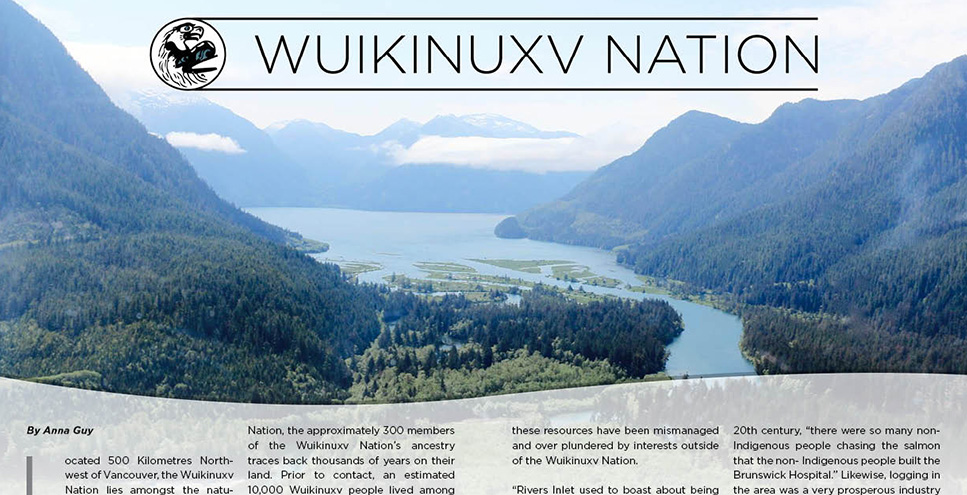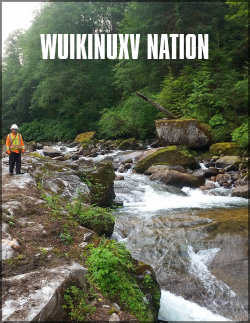By Anna Guy
Located 500 Kilometres Northwest of Vancouver, the Wuikinuxv Nation lies amongst the natural beauty of British Columbia’s central coast region, accessibly only by a 45-minute seaplane or a two-and-a-half-hour boat ride. A small but proud Nation, the approximately 300 members of the Wuikinuxv Nation’s ancestry traces back thousands of years on their land. Prior to contact, an estimated 10,000 Wuikinuxv people lived among the areas now known as Kilbella, Moses Inlet, Hardy Inlet, and Rivers Inlet. Pre-contact, the Nation enjoyed very rich sea and timber resources, but over time these resources have been mismanaged and over plundered by interests outside of the Wuikinuxv Nation.
“Rivers Inlet used to boast about being the second largest sockeye producing system on the Pacific Coast,” Dan Smith, Tribal Manager, tells Business Elite Canada. At one point in the early 20th century, “there were so many non-Indigenous people chasing the salmon that the non- Indigenous people built the Brunswick Hospital.” Likewise, logging in the area was a very prosperous industry for decades.
But the natural resources were a gift and a curse. Because the nation, as with many other coastal First Nations, was seen as rich in marine and forest resources, it was determined by the Indian Agent that Coastal First Nations did not need their traditional territories for their socio-economic benefit, essentially robbing the nation of opportunities for self-sustainment.
“Viable economic opportunities are limited for all coastal communities due to over-fishing and depletion of the forest from over harvesting,” says Smith. But the Wuikinuxv Nation has a legacy of resourcefulness, and that trait is in as full force now in 2019 as ever.
Nicknaqueet River Hydropower project
Because of the remote nature of the Nation, Reliable access to electricity was a challenge. The community relied heavily on diesel fuel. “As the years passed, Wuikinuxv Nation was consuming 350,000 liters of diesel fuel a year; placing Wuikinuxv in a deficit situation,” says Smith.
For over 40 years, there was a vision to harness clean hydroelectric from the Wannock River for the community, a vision that came to fruition in the form of the Nicknaqueet Hydro Project, a 350kW hydropower project that came online in 2018. The hydro project now supplies 97 per cent of Rivers Inlet’s electrical needs.
“To the credit of Indigenous Services Canada and other funding sources who contributed to clean energy, Wuikinuxv will have a reliable and sustainable source of energy that costs less for today and future generations,” says Smith. “The people are happy about the hydro project as it is a relief not to continue worrying about having enough candles and worrying about all your frozen foods defrosting.”
The salmon population in the River was a major priority in the project, down to the type of method used for the project. Typically, hydropower generators require a dam, but those pose great threats to spawning grounds and wasn’t a viable option. Instead, the Nicknaqueet Hydro Project uses run-of-river, a method that uses part of natural stream flows and natural elevation differences found in mountainous regions like this.
Wuikinuxv Nation Councillor, Rick Shaw, says, “The Nicknaqueet hydro plant has been a 40-year dream in the making. Through countless feasibility studies, numerous meetings, and many, many hours of planning, we are now so proud to call this our own.”
“This foot print was a long time in the making,” says Chief Frank Johnson, who noted the resilience and foresight of previous leadership to achieve Wuikinuxv’s dream. “You should have heard the sounds of joy and elation on the VHF when the announcement was made that we have now switched from our diesel generator to our hydro plant. Gianakaci .”
Wuikinuxv Nation received the 2018 Clean Energy BC Award for the development of this project. The connection to the land is very strong, as demonstrated by each family being represented by a crest such as the Five-Fin killer whale, eagle, raven, and bear. The Nicknaqueet River hydroelectric power facility is a powerful step in the right direction towards revitalizing the area’s natural states. The clean power produced by the plant will also reduce shipments of diesel fuel through sensitive coastal waterways and the potential for environmental contamination from the storage of fuel on reserve.







